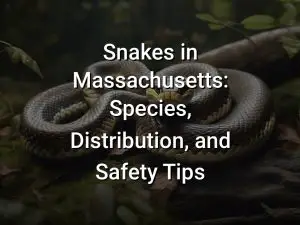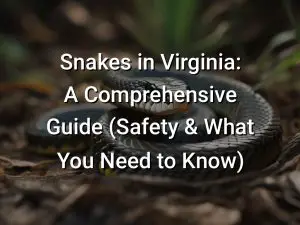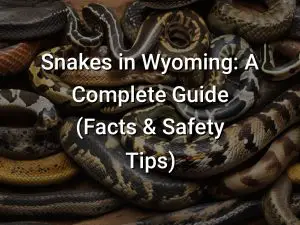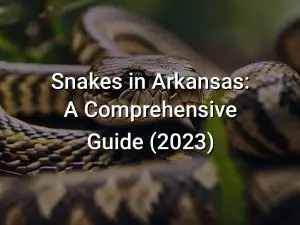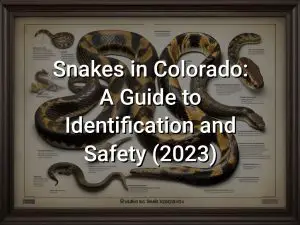Snakes in Tennessee: Common Species and Safety Tips

Tennessee is home to a diverse range of wildlife, including several species of snakes. For some, the idea of encountering a snake may send shivers down their spine, but these reptiles play an important role in the ecosystem. In this article, we’ll explore the common species of snakes found in Tennessee and provide some valuable safety tips for those who may come across them.
From the venomous Eastern Diamondback Rattlesnake to the harmless Garter Snake, Tennessee is home to a variety of snake species. Understanding their behaviors, habitats, and identifying characteristics can help us coexist peacefully with these fascinating creatures. So let’s dive in and learn more about these slithering residents of the Volunteer State!
Quick Links
Introduction
Tennessee is home to a diverse range of snake species, some of which are venomous and pose a potential threat to humans. It is important to be aware of the common snake species in Tennessee and to know how to stay safe when encountering them.
Snakes play a vital role in the ecosystem, controlling rodent populations and maintaining a balanced ecosystem. While many snakes are harmless and beneficial, it is essential to exercise caution and respect when encountering them in their natural habitats.
This article will provide an overview of the common snake species in Tennessee and offer safety tips to help you minimize the risks associated with snakes. By understanding the snakes and following proper safety precautions, you can coexist with these fascinating creatures and enjoy the beauty of Tennessee’s natural landscapes.
Eastern Diamondback Rattlesnake
The Eastern Diamondback Rattlesnake is one of the venomous snake species found in Tennessee. It is the largest venomous snake in North America, reaching lengths of up to 8 feet. This species is characterized by its diamond-shaped markings and rattle at the end of its tail.
The Eastern Diamondback Rattlesnake is typically found in wooded areas and grasslands, where it preys on small mammals, birds, and reptiles. While it generally avoids human interaction, encounters can occur in outdoor recreational areas.
If you come across an Eastern Diamondback Rattlesnake in Tennessee, it is important to keep your distance and not provoke or attempt to handle the snake. These snakes will typically give a warning rattle before striking, so staying calm and slowly backing away is the best course of action.
If bitten by an Eastern Diamondback Rattlesnake, seek medical attention immediately. These snakes have potent venom that can cause severe symptoms, including pain, swelling, and tissue damage. Anti-venom is available and can be administered by medical professionals to counteract the effects of the snakebite.
It’s important to be aware of the presence of Eastern Diamondback Rattlesnakes in Tennessee and take precautions when enjoying outdoor activities in snake habitat. Wearing closed-toe shoes, staying on designated trails, and using a flashlight at night can help reduce the risk of snake encounters.
Remember, snakes play an important role in the ecosystem and should be respected from a safe distance. Educating yourself about the common snake species in Tennessee and following safety guidelines can help ensure a positive outdoor experience.
Copperhead
The Copperhead is one of the venomous snake species found in Tennessee. It is a pit viper, known for its distinctive copper-colored head and hourglass-shaped patterns on its body. The Copperhead can be found in wooded areas, rocky bluffs, and near bodies of water, making encounters with humans possible.
Although the Copperhead is venomous, its bite is rarely fatal to humans. Most bites result in mild to moderate symptoms, such as swelling, pain, and redness at the bite site. However, it is still important to exercise caution and be aware of their presence to avoid potential bites.
If you encounter a Copperhead, it is best to keep your distance and give the snake space to retreat. Do not attempt to handle or provoke the snake. If you are bitten by a Copperhead, seek medical attention immediately. Do not try to suck out the venom or apply a tourniquet, as these methods are ineffective and can cause further harm.
To reduce the risk of encountering a Copperhead or any other snake species in Tennessee, it is important to take certain precautions. When hiking or spending time in areas where snakes may be present, wear sturdy footwear and long pants. Avoid walking through tall grass or brush without being able to see where you are stepping.
It is also helpful to be aware of the snake’s behavior. Copperheads are most active from April to October, particularly during warmer months. They are typically more active at night, so it is advisable to be cautious during evening hours. Be mindful of your surroundings and keep an eye out for any signs of snakes, such as their characteristic pattern.
By understanding the behavior and habitat of Copperheads and practicing safety measures, you can minimize the risk of snake encounters and ensure your own safety while enjoying Tennessee’s outdoor spaces.
Cottonmouth
The Cottonmouth, also known as the Water Moccasin, is a venomous snake species that can be found in Tennessee. It is a large snake, typically measuring between 30 and 48 inches in length. The Cottonmouth gets its name from its distinctive white mouth, which it displays as a warning when threatened.
Cottonmouths are semi-aquatic snakes and can often be found near bodies of water, such as swamps, rivers, and marshes. They are excellent swimmers and are known for their ability to swim with their heads above water, which gives them the appearance of cotton floating on the surface.
The venom of the Cottonmouth is potent and can cause severe pain, swelling, and tissue damage. If you encounter a Cottonmouth in the wild, it is important to keep your distance and not provoke or handle the snake. If bitten, seek immediate medical attention.
Like other snakes, the Cottonmouth plays an important role in the ecosystem as a predator, controlling populations of small mammals and amphibians. While they can be intimidating, it is important to remember that snakes generally prefer to avoid human contact and will only bite in self-defense.
When exploring areas where Cottonmouths may be present, such as wetland areas or near bodies of water, it is important to take precautions to reduce the risk of encountering a snake. Wear long pants and closed-toe shoes, avoid reaching into crevices or under rocks, and watch where you step.
By being aware of the presence of Cottonmouths and following safety guidelines, you can enjoy outdoor activities in Tennessee while minimizing the risk of snake encounters.
Timber Rattlesnake
The timber rattlesnake is a venomous snake species found in Tennessee. It is easily recognized by its distinctive rattling tail, which it uses to warn potential threats. Here are some key facts about the timber rattlesnake:
- The timber rattlesnake is the only venomous snake species in Tennessee with a state-wide distribution.
- It can be found in a variety of habitats, including forests, rocky areas, and even swamps.
- The snake’s coloration varies, but it typically has a pattern of dark brown or black bands on a lighter background.
- Adult timber rattlesnakes can reach lengths of up to 5 feet, although most individuals are smaller.
- They are ambush predators, patiently waiting for small mammals, birds, and reptiles to come within striking distance.
- Timber rattlesnakes are timid and will generally try to avoid human encounters.
- If threatened, they may rattle their tails and coil up in a defensive posture.
- Although bites from timber rattlesnakes are rare, they can be dangerous and require immediate medical attention.
If you encounter a timber rattlesnake in the wild, it is important to keep your distance and give the snake ample space to retreat. Avoid provoking or antagonizing the snake, as this may increase the likelihood of a defensive response. By respecting the snake’s space and observing it from a safe distance, you can coexist with these fascinating creatures while minimizing the risk of a negative encounter.
If you are bitten by a timber rattlesnake or any other snake, seek medical attention immediately. Stay calm and try to keep the affected area still and below the level of your heart to slow the spread of venom. Do not attempt to suck out the venom or apply a tourniquet, as these methods have been proven to be ineffective and can cause more harm than good.
Remember, snakes play an important role in the ecosystem and should be respected and appreciated from a safe distance. By understanding the common snake species in Tennessee and following safety tips, you can enjoy nature while minimizing potential risks.
Black Rat Snake
The black rat snake, also known as the eastern rat snake, is a non-venomous snake species that is commonly found in Tennessee. It is one of the largest snake species in the state, reaching lengths of up to 8 feet.
The black rat snake has a shiny black body with white or yellowish markings on its belly. It is known for its excellent climbing abilities and can often be found in trees or other elevated areas. It is also a skilled swimmer and can be found near bodies of water.
Black rat snakes are constrictors, meaning they kill their prey by wrapping around them and squeezing. They primarily eat small mammals such as rats, mice, and squirrels, but they are also known to eat birds and their eggs.
Despite their size, black rat snakes are generally non-aggressive and will usually try to avoid humans. If confronted, they may hiss, vibrate their tail, or bite as a defensive measure, so it is important to give them space and not provoke them.
Having black rat snakes around can actually be beneficial, as they help control rodent populations. If you encounter a black rat snake on your property, it is best to leave it alone and let it go about its natural behavior.
If you are concerned about snakes on your property, there are measures you can take to deter them, such as keeping your yard clean and free of potential hiding spots, sealing any cracks or holes in your home, and removing sources of food that may attract snakes.
Remember, it is important to always treat snakes with caution and respect. If you are unsure about the identity of a snake or need assistance with snake removal, it is recommended to contact a professional wildlife control service.
Eastern Coral Snake
The Eastern Coral Snake is a venomous snake species found in Tennessee and other parts of the southeastern United States. It has a distinctive pattern of bright red, yellow, and black bands, which serves as a warning to potential predators.
The Eastern Coral Snake is not commonly encountered by humans, as it spends most of its time underground or hidden in leaf litter. However, if you do come across an Eastern Coral Snake, it is important to exercise caution and give it a wide berth.
This snake has a potent venom that affects the nervous system, and its bites can be life-threatening. It is characterized by neurotoxic symptoms such as muscle weakness, difficulty breathing, and paralysis. If bitten by an Eastern Coral Snake, seek medical attention immediately.
Preventing encounters with snakes, including the Eastern Coral Snake, is the best way to stay safe. Avoid walking through areas with tall grass or underbrush where snakes may be hiding. Wear protective clothing, such as long pants and boots, when hiking or working outdoors. And always be aware of your surroundings.
If you do encounter a snake and are unsure if it is a Eastern Coral Snake or another venomous species, it is best to avoid it altogether. Remember, it is always better to be safe than sorry when it comes to snake encounters.
Ring-Necked Snake
The Ring-Necked Snake is a small, non-venomous snake that is commonly found in Tennessee. It gets its name from the distinctive yellow or orange ring around its neck, although this ring may not always be visible. The rest of its body is usually a dark color, such as black or dark gray.
These snakes are relatively small, typically growing to be about 10-15 inches long. They have smooth and shiny scales, giving them a sleek appearance. Ring-Necked Snakes are most active at night and prefer to hide under rocks, logs, or leaf litter during the day.
Ring-Necked Snakes primarily feed on small invertebrates, such as worms, slugs, and insects. They are not dangerous to humans and are generally shy and non-aggressive. If threatened, they may release a musky odor or try to bite, but their bite is harmless.
When it comes to habitat, Ring-Necked Snakes prefer moist environments, including forests, woodlands, and marshy areas. They can also be found in suburban and urban areas, particularly near bodies of water.
It’s important to note that although Ring-Necked Snakes are not venomous and pose no threat to humans, it’s still best to avoid handling them. Snakes play a vital role in the ecosystem and should be left undisturbed in their natural habitats.
Northern Water Snake
The Northern Water Snake is a common snake species found in Tennessee. It is a non-venomous snake that is often mistaken for the venomous Cottonmouth due to its similar appearance and aquatic habitat. However, the Northern Water Snake has round pupils, while the Cottonmouth has elliptical pupils.
These snakes are typically found near bodies of water, such as streams, rivers, and lakes. They are excellent swimmers and can often be seen basking on rocks or logs near the water’s edge. Although they are not venomous, Northern Water Snakes will bite if threatened or cornered.
The Northern Water Snake feeds primarily on small fish, frogs, and other aquatic prey. They are active during the day and night, especially during the warmer months. Like other snakes, they play a crucial role in controlling rodent populations and maintaining the ecological balance of their habitat.
If you encounter a Northern Water Snake, it is best to give it space and observe it from a safe distance. Do not attempt to handle or disturb the snake, as it may bite in self-defense. It is important to remember that snakes are an important part of the natural ecosystem and should be respected and protected.
Garter Snake
Garter snakes are a common species of snake found in Tennessee. They are known for their slender bodies, distinct stripes, and non-aggressive nature. Garter snakes are usually harmless and play a beneficial role in controlling populations of rodents and insects.
These snakes are typically found in a variety of habitats, including forests, fields, wetlands, and gardens. They are adaptable and can even be found in urban areas. Garter snakes are active during the day and can often be seen basking in the sun or hunting for food.
Despite their relatively low risk to humans, it’s still important to exercise caution when encountering a garter snake. Like all snakes, garter snakes can bite if they feel threatened or cornered. While their venom is mild and non-life-threatening to humans, it can still cause discomfort and swelling.
If you come across a garter snake, it’s best to give it space and avoid startling or handling it. If you need to move it out of your yard or garden, use a broom or long object to gently guide it in the desired direction. It’s important to remember that garter snakes are protected by state laws and should not be harmed or killed.
By understanding and respecting these fascinating creatures, we can coexist with garter snakes and appreciate their role in our ecosystem. If you have any concerns about snakes on your property, it’s always best to contact a local wildlife professional for assistance.
Safety Tips
When encountering snakes in Tennessee, it’s important to prioritize safety and take necessary precautions. Here are some safety tips to keep in mind:
- Stay calm and do not provoke or approach snakes. Give them space and avoid sudden movements.
- Learn to identify venomous snakes common in Tennessee, such as the Eastern Diamondback Rattlesnake, Copperhead, Cottonmouth, and Timber Rattlesnake.
- Wear appropriate footwear and clothing when hiking or working outdoors to protect against snake bites.
- Be cautious near rocky areas, woodpiles, and dense vegetation, as these are common hiding spots for snakes.
- Do not handle snakes, even if you believe they are non-venomous. Non-venomous snakes can still bite if they feel threatened.
- If you encounter a snake, slowly and calmly back away from it. Give the snake a wide berth to ensure your safety.
- If you or someone else is bitten by a snake, seek immediate medical attention. Stay calm and try to remember the snake’s appearance to help with medical treatment.
- It is important to remember that most snakes in Tennessee are non-venomous and pose no threat to humans.
- Keep your yard clean and remove potential snake hiding spots, such as piles of debris or overgrown vegetation.
- Consider installing snake-proof fencing in areas where snakes are a concern, such as around gardens or play areas.
By following these safety tips, you can minimize the risk of snake encounters and ensure a safe outdoor experience in Tennessee.
Conclusion
With a variety of snake species present in Tennessee, it’s important to be aware of the potential dangers and take necessary precautions when encountering snakes in the wild. By familiarizing yourself with the common species and their characteristics, you can better navigate outdoor areas and minimize the risk of snake bites.
Remember to always respect the natural habitat of these snakes and give them their space. If you do encounter a snake, it’s best to observe from a safe distance and not provoke or attempt to handle it. Additionally, following the safety tips provided in this article, such as wearing appropriate footwear and staying on designated paths, can help reduce the likelihood of snake encounters and keep you and your fellow outdoor enthusiasts safe.
Remember, knowledge is power when it comes to staying safe in nature. Enjoy your outdoor adventures in Tennessee and embrace the beauty and diversity of the wildlife, including the fascinating snakes that call this state home. Stay informed, take precautions, and have a wonderful time exploring the great outdoors!

